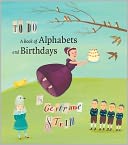 To Do: A Book of Alphabets and Birthdays
To Do: A Book of Alphabets and Birthdays
by Gertrude Stein
Yale University Press. 128 pages, $25.
NEVER PUBLISHED during her lifetime, To Do is an abecedarian book with as much child appeal as an Edward Gorey “A is for …” book. This was actually Stein’s second book written for children. The first, published by William R. Scott in 1939, was called The World is Round and was commissioned for inclusion in the innovative educational programs at the Bank Street School in New York. Based on the favorable reception it received, Stein decided to write another.
To Do was rejected by numerous publishers, and even her friend Carl Van Vechten was unable to place it. Another of Scott’s writers, Margaret Wise Brown, famed as the author of Goodnight Moon (1947), praised it, but to no avail. (It is fascinating to note that Margaret Wise Brown was probably bisexual; her longest-lasting relationship was with a woman named Michael Strange, née Blanche Oelrichs, a poet and actress famous in her day, who had once been married to John Barrymore.) Finally, the economic realities of the war years further delayed its publication. First brought out without illustrations by Yale University Press in 1957, this new edition represents the first to have illustrations.
The characters in To Do include children and adults, animals and concepts. Most have birthdays that travel across the calendar or cease to occur. Animals turn into people or objects. In the first chapter, Active, a horse, is the main character for the letter A. Active (who was “young and tender and pretty slender” even at the age of twenty) had once been called Kiki, a name that turns up later in the book. Active is transformed into an automobile, but many of her characters meet ends that are sad, or bad, or they just drift away. Some of the characters are those who have been found in the pages of this magazine. “Sammy” is Stein and Toklas’ friend Samuel Steward; “Georgie” is their friend George Platt Lynes; and “Van” is Carl Van Vechten.
Not all of her characters represent members of the Stein/ Toklas circle, but one of the least known is Katy Buss, who shows up as one of the “K” characters. Also known as Kate or Kitty, she was one of Stein’s closest friends. Buss was a journalist, poet, and critic from a well-off family in the Greater Boston area. Through Buss, Stein negotiated with Edward Brown of the Four Seas Press in Boston to publish Geography & Plays at a cost of $2,500. (Edward Brown had published Buss’s Studies in the Chinese Drama in 1922.) Buss was the author of Jevons Block: A Book of Sex Enmity (1917), a collection of poems and illustrations in which characters (poetry bookseller, hairdresser, dance teacher, manicurist, and so on) express their dismay about their lot in life and feelings about the opposite sex.
Buss believed deeply in Stein’s work, read it all, offered criticism, and was the object of one of Stein’s word portraits, published in Portraits and Prayers (1934). Illustrating the letter K, Stein wrote of Buss: “K is Kiki, Katy, Cake and Kisses./ … Katy Buss knew how to make cake. She made it./ Katy Buss knew how to kiss/ She kissed it./ Katy Buss knew Kiki Buss. …/ Her birthday was on the fifteenth./ After that it was on the twenty-first/ … Always the same month always the same year and that was queer./ Necessary but queer./ … Who knows what a cow does./ A cow chews its cud/ Who knows what Katy Buss does.” The cow chewing its cud may be a reference to Stein’s 1926 A Book Concluding With As A Wife Has A Cow: A Love Story. The name Kiki may have been a reference to Kiki de Montparnasse (née Alice Prin), a model and muse in 1920’s Paris. (Kiki as a synonym for lesbian does not appear to have entered the slang lexicon until the 1950’s.)
Giselle Potter, the prolific and award-winning illustrator for the New Yorker (whose parents once ran a traveling puppet theater), has provided exquisite illustrations. The faces of the adults and children are reminiscent of American primitive portraits from the 17th century, but they are clad in 1930’s-style outfits.





